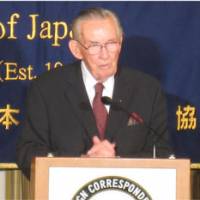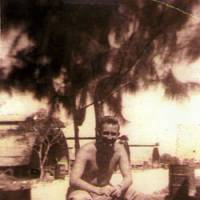Free-falling from approximately 27,000 feet after his B-29 was critically damaged while flying over the Kanto region, Raymond "Hap" Halloran was all but certain his fate had been sealed.
The navigator-bombardier was parachuting down behind enemy lines, more than 2,400 km from his base on Saipan. It was January 1945.
"It was a quiet fall," Halloran, 86, said at the Foreign Correspondents' Club of Japan in Tokyo earlier this month.
After hitting the ground, "I put my hands in the air and surrendered," he said.
Although the then 22-year-old Ohio native survived the fall, he was roughed up by locals in Chiba Prefecture before being taken to a POW camp. He endured degrading torture, including being displayed naked inside a cage in a zoo, and lived through the Great Tokyo Air Raid of March 10, 1945.
Halloran suffered for seven months, leaving him with trauma that continued well after the war. But Halloran has returned to Japan 11 times since 1984.
"Maybe if I go back and see these people and judge them for who they really are, they are entitled to my judgment rather than hatred and misjudgment," Halloran said as he explained his reasons for revisiting his former enemies.
"So I said, 'I've got to go back.' "
Born in Cincinnati in February 1922, Halloran volunteered for the U.S. Army Air Corps after learning of Japan's 1941 attack on Pearl Harbor. Following the completion of his training, his team was dispatched to Saipan, where the 73rd Wing Base staged missions targeting mainland Japan.
"The brand-new B-29 was a thing of beauty," he said, recalling the day he saw his plane.
Beginning in December 1944, Halloran boarded the bomber with 10 other crewmen on assignments to attack Iwo Jima, Nagoya and the Kobe area.
The missions were successful, but that "doesn't mean you get delighted," the veteran said, because the war "could have gone on for years" had the United States taken a less aggressive approach.
On his fourth mission, which targeted the Nakajima aircraft factory in western Tokyo, his plane was shot down by Japanese twin-engine fighters.
During that mission on Jan. 27, 1945, three of the plane's engines caught fire and the Ohioan evacuated through the front bomb bay. His hands grew numb as he was exposed to the freezing outside temperature, but he managed to control the parachute during the descent.
"Only five of the crewmen evacuated the plane. That's all I want to say" about the crash, Halloran said.
Held by the military police at a prison in Tokyo for 67 days in solitary confinement, Halloran was given small rice balls for meals and quickly lost more than 30 kg. His skin had rashes from lice and flea bites. No medical care was provided.
Then, in April 1945, he was told to leave his cell and follow the guards while they put a blindfold and tied his hands with rope.
"They told me to take my shoes, which meant it was my final day," Halloran said of his fears of being executed.
But instead of being sent to the gallows, he was taken to Ueno Zoo in Taito Ward and put on display, naked, in a tiger cage.
Despite the attempt by the Japanese military to humiliate him, Halloran remembers observing different reactions from the crowd.
"I thought I saw compassion (in the eyes of onlookers.) It was maybe because I wanted to see it," he recalled. "I needed somebody on my side" to give a little hope.
Halloran, who spent more than two months in a military torture prison near the Imperial Palace, also survived the massive air raids on Tokyo by his countrymen.
On March 10, 1945, during what later came to be known as the Great Tokyo Air Raid, he witnessed the spreading fires and heard the screaming children outside his cell.
"It was a terrible night. Terrible," he said, recalling the incident in which 100,000 people were killed overnight.
Although Halloran was released from prison after Japan's surrender in August 1945, he was physically unfit to immediately return home. It took him about a year to be released from a hospital in West Virginia and leave the service.
But the traumatic experiences lingered for nearly four decades, taking hold of his life. Although he attempted to bury his past, he endured nightmares for years afterward.
In 1984, the veteran finally felt that instead of avoiding his former enemy, he had to face his demons and attempt some kind of reconciliation with his past.
Since 1984, Halloran has visited Japan for tours in Hiroshima and Nagasaki and to meet his former enemies, including the pilot who took down his B-29. In 1998 he published a book — "Hap's War" — in which he chronicled his wartime experiences.
Today, Halloran donates annual checks to the Center of the Tokyo Raid and War Damages in Koto Ward.
He has given so many speeches on his wartime experiences that he can even joke about his confinement in Japan. "One guard would come up to (his cell) and tell me 'ohayo' (good morning)," during the imprisonment, Halloran said.
"I thought he was trying to make me homesick for Cincinnati, Ohio," he chuckled.
But asked what it would take for peace to prevail for future generations, Halloran thought for a moment and replied in a low tone.
"I do not have the answer to that," he said, adding only that there are no winners in war.
In this series, The Japan Times interview firsthand witnesses of Japan's march to war and ensuing defeat who wish to pass on their experiences to younger generations. This is the 17th installment of the Witness to War series. To read more, see the Witness to War archive.



















With your current subscription plan you can comment on stories. However, before writing your first comment, please create a display name in the Profile section of your subscriber account page.